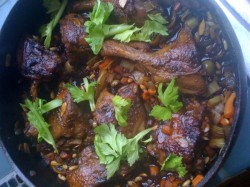This recipe was kindly sent by Paula Wolfert. It’s an adaptation of a recipe in her 2009 book “Mediterranean Clay Pot Cooking“. It features preparing the duck by gentle steaming, instead of braising. In Paula’s words, “I changed it in order to use your (lidded) colander rather than a pot. I did this because I’m convinced that steaming rather than braising duck legs produces an incredibly luscious texture. Especially slow steaming in stoneware rather than metal.”
Duck Agrodolce with Grape Syrup, Pine Nuts, and Almonds
Paula Wolfert, 2011
Serves 6 to 8
CLAY Steamer plus a 3 or 4 quart glazed or unglazed earthenware casserole
6 thick celery ribs plus some leaves
6 to 8 large duck legs
2 sliced garlic cloves,
2 bay leaves,
¼ bunch fresh parsley, coarsely chopped
Coarse sea salt
1/2 teaspoon lightly crushed black peppercorns
l bruised cinnamon stick
1 medium onion, finely chopped, plus 1 slice of onion
3 tablespoons extra virgin olive oil
¾ cup finely diced carrots
1 1/2 tablespoons capers, drained and rinsed
½ cup pitted green olives, drained and rinsed
3 tablespoons currants
2 tablespoons pine nuts, toasted
¼ cup sliced almonds, toasted
6 tablespoons grape molasses, grape syrup, Italian Saba, Greek pekmez, or Spanish arrop,
1/3 cup red wine
¼ cup red wine vinegar and 2 teaspoons sugar, or more to taste
Celery leaf sprigs and a few red pepper flakes for garnish
1 Trim and ”string” the celery stalks. Save the strings and trimmed stalks for step 2. Cut the celery into ½ inch slices and hold. Set aside the leaves for garnish.
2. Set a steamer, preferably clay or stoneware, over a deep pot filled with a penny and boiling water. Rinse the duck; let drain, do not remove any fat, but do prick the skin side of each thigh. In a bowl mix the reserved celery trimmings and strings, garlic, parsley, salt and pepper, cinnamon stick and l slice of onion. Place about 1/3 the mixture in the steamer, arrange half the ducks, skin side down on top, Repeat and end with the herb-garlic mixture. Cover with a foil dome and steam for about 1½ hour. If the coin stops “clicking,” add boiling water to the pot.
3. Meanwhile cook the celery in a conventional skillet filled with salted water until tender, about 10 minutes; drain and set aside. Wipe out the skillet and set aside for step 7.
4. Place half the olive oil, the carrot, the chopped onion and a pinch of salt in the casserole; set over a heat diffuser, cover and cook until tender, about 10 minutes. Uncover and continue cooking until the onion is golden. Add the capers, olives, currants, pine nuts and almonds; stir well and set aside.
5 When the duck legs have steamed for 1 1/2 hours, transfer to sheets of paper toweling, scrape off all the herbs and leave them to cool for at least 15 minutes..
6. Meanwhile skim the liquid in the steaming pot and save the fat for some other purpose. Use the pot to boil down the skimmed liquid to one half. Set aside 2 cups for step 7; reserve or discard the remaining liquid.
7. Heat the remaining oil and 3 tablespoons of the duck fat in the conventional skillet (see step 3). Working in batches quickly fry the duck legs on both sides. Remove the duck legs to a wooden slab and cut each in half at the joint. Pour off the fat in the skillet, add 3 tablespoons of the grape syrup or molasses and boil until thick and bubbly. Add the remaining grape syrup or molasses and 1/3 cup red wine and boil down to a glaze. Over medium low heat, slide the duck pieces, a few at a time, into the glaze to coat on all sides. Transfer the glazed duck portions to the casserole. When all the duck has been glazed, add 2 cups of the reduced liquid (see step 6), ¼ cup red wine vinegar and 2 teaspoon sugar to the glazed grape syrup in the skillet and boil down to one half. Pour over the duck; add the celery and mix gently to combine. Bring the contents of the casserole to a boil; reduce the heat, cover, and cook over gentle heat until the duck is completely tender, about 30 minutes.
8. Correct the seasoning with salt and pepper. Garnish with sprigs of fresh celery and pinches of hot red pepper and serve directly from the pot.
Paula Wolfert, 2011
